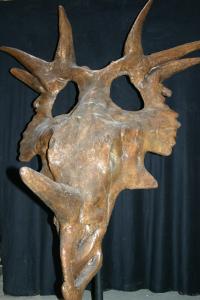
Styracosaurus skull A "spectacular beast" is coming back to its original stomping grounds and making a new home at the University of Alberta--a coup that will allow its researchers to study the rare dinosaur skull up close.
"This is a very dramatic beast," said Dr. Michael Caldwell, a palaeontolgist who was instrumental in getting the skull to the U of A. "What we will have is a cast, but the specimen is one of a kind in the world. This is the last cast from the original mould and when you have a research quality cast where it is duplicated right down to a freckle, it doesn't get any better than that."
The fossils from this large herbivorous dinosaur were first found by the Sternberg family, who were hired by the Geological Survey of Canada to compete with Americans coming to Alberta to collect fossils. The Sternbergs gathered all kinds of bones, including the skull of Styracosaurus albertensis. "The specimen was perfect," says Caldwell. "And it's a big one--the skull is two metres long."
Styracosaurus had six long horns extending from its neck frill, a smaller horn above each of its eyes and a single horn protruding from its nose. It was a large dinosaur that could reach lengths of five metres and weigh as much as three tonnes. For almost a century, the original skull of Styracosaurus albertensis has been at the Canadian Museum of Nature in Ottawa. Now a cast of that specimen is on its way to Edmonton in a huge wooden crate on the back of a flatbed truck.
Recently, Caldwell and a group of U of A researchers attended the Annual Meeting of the Society of Vertebrate Paleontology in Ottawa which coincided with the opening of the new fossil gallery at the Canadian Museum of Nature. In order to commemorate this coincidence the museum offered up a cast of this Alberta dinosaur's skull at the Annual Meeting Auction--the proceeds go to student research and travel grants. Using funds raised by a gala event Caldwell throws every year at the U of A's Faculty Club to augment the faculty's teaching and research collections, he bid on the unique cast. In the end, he paid $8300 U.S. for the skull--the bidding came down to the U of A and an American museum--which retails at $12,500 U.S.
"It was a fine moment to know that this spectacular specimen would be coming back to Alberta," said Caldwell. "It will mean a lot to the research program at the U of A to be able to verify and compare other animals to this one."
Renowned dinosaur expert Dr. Philip Currie agrees. Aside from saving him numerous trips to Ottawa, the skull will provide countless research opportunities for other scientists and students.
"This is a dinosaur that is more familiar to people just because it's so bizarre looking," says Currie, also in the Faculty of Science at the U of A. "For me, this is a coup because I am also studying skulls of Centrosaurus and Pachyrhinosaurus, which are the most closely related to the Styracosaurus so it will be much easier to make comparisons.
"As well, staff of the Tyrrell Museum will make much use of it and students will be able to learn a lot from it. This is a skull that will be very much in demand."
Source : University of Alberta
 Print Article
Print Article Mail to a Friend
Mail to a Friend
